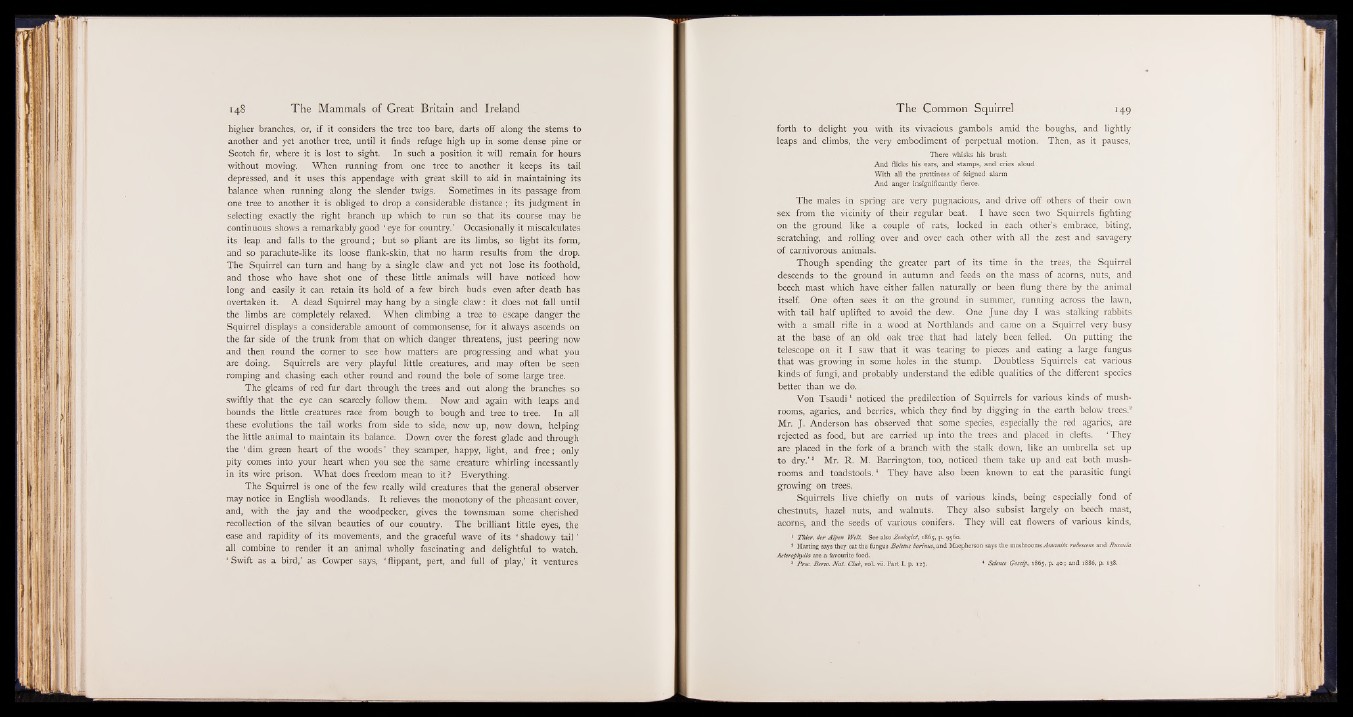
higher branches, or, if it considers the tree too bare, darts off along the stems to
another and yet another tree, until it finds refuge high up in some dense pine or
Scotch fir, where it is lost to sight. In such a position it will remain for hours
without moving. When running from one tree to another it keeps its tail
depressed, and it uses this appendage with great skill to aid in maintaining its
balance when running along the slender twigs. Sometimes in its passage from
one tree to another it is obliged to drop a considerable distance; its judgment in
selecting exactly the right branch up which to run so that its course may be
continuous shows a remarkably good ‘ eye for country.’ Occasionally it miscalculates
its leap and falls to the ground; but so pliant are its limbs, so light its form,
and so parachute-like its loose flank-skin, that no harm results from the drop.
The Squirrel can turn and hang by a single claw and yet not lose its foothold,
and those who have shot one of these little animals will have noticed how
long and easily it can retain its hold of a few birch buds even after death has
overtaken it. A dead Squirrel may hang by a single claw: it does not fall until
the limbs are completely relaxed. When climbing a tree to escape danger the
Squirrel displays a considerable amount of commonsense, for it always ascends on
the far side of the trunk from that on which danger threatens, just peering now
and then round the corner to see how matters are progressing and what you
are doing. Squirrels are very playful little creatures, and may often be seen
romping and chasing each other round and round the bole of some large tree.
The gleams of red fur dart through the trees and out along the branches so
swiftly that the eye can scarcely follow them. Now and again with leaps and
bounds the little creatures race from bough to bough and tree to tree. In all
these evolutions the tail works from side to side, now up, now down, helping
the little animal to maintain its balance. Down over the forest glade and through
the ‘ dim green heart of the woods ’ they scamper, happy, light, and free; only
pity comes into your heart when you see the same creature whirling incessantly
in its wire prison. What does freedom mean to it? Everything.
The Squirrel is one of the few really wild creatures that the general observer
may notice in English woodlands. It relieves the monotony of the pheasant cover,
and, with the jay and the woodpecker, gives the townsman some cherished
recollection of the silvan beauties of our country. The brilliant little eyes, the
ease and rapidity of its movements, and the graceful wave of its ‘ shadowy tail ’
all combine to render it an animal wholly fascinating and delightful to watch.
‘ Swift as a bird,’ as Cowper says, ‘ flippant, pert, and full of play,’ it ventures
forth to delight you with its vivacious gambols amid the
leaps and climbs, the very embodiment of perpetual motion.
There whisks his brush
And flicks his ears, and stamps, and cries aloud
With all the prettiness o f feigned alarm
And anger insignificantly fierce:
The males in spring are very pugnacious, and drive off others of their own
sex from the vicinity of their regular beat. I have seen two Squirrels fighting
on the ground like a couple of rats, locked in each other’s embrace, biting,
scratching, and rolling over and over each other with all the zest and savagery
of carnivorous animals.
Though spending the greater part of its time in the trees, the Squirrel
descends to the ground in autumn and feeds on the mass of acorns, nuts, and
beech mast which have either fallen naturally or been flung there by the animal
itself. One often sees it on the ground in summer, running across the lawn,
with tail half uplifted to avoid the dew. One June day I was stalking rabbits
with a small rifle in a wood at Northlands and came on a Squirrel very busy
at the base of an old oak tree that had lately been felled. On putting the
telescope on it I saw that it was tearing to pieces and eating a large fungus
that was growing in some holes in the stump. Doubtless Squirrels eat various
kinds of fungi, and probably understand the edible qualities of the different species
better than we do.
Von Tsaudi1 noticed the predilection of Squirrels for various kinds of mushrooms,
agarics, and berries, which they find by digging in the earth below trees.2
Mr. J . Anderson has observed that some species, especially the red agarics, are
rejected as food, but are carried up into the trees and placed in clefts. ‘ They
are placed in the fork of a branch with the stalk down, like an umbrella set up
to dry.’ 8 Mr. R. M. Barrington, too, noticed them take up and eat both mushrooms
and toadstools.4 They have also been known to eat the parasitic fungi
growing on trees.
Squirrels live chiefly on nuts of various kinds, being especially fond of
chestnuts, hazel nuts, and walnuts. They also subsist largely on beech mast,
acorns, and the seeds of various conifers. They will eat flowers of various kinds,
1 Thier. der Alpen Welt. See also Zoologist, 1865, p. 9560.
* Harting says they eat the fungus Boletus borinus, and Macpherson says the mushrooms Amanita rubescens and Russula
heterophylla are a favourite food.
3 Proc. Bent). Nat. Club, vol. vii. Part I. p. 127.
boughs, and lightly
Then, as it pauses,
4 Science Gossip, 1865, p. 40; and 1886, p. 138.